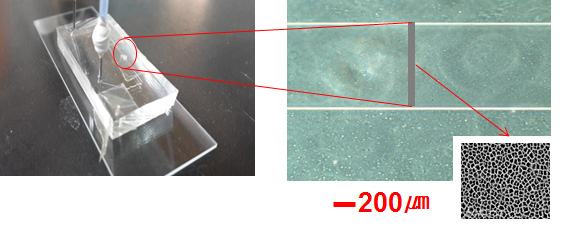Nanoporous membrane-embedded external power-free microfluidic biosensor
-
1
Chungnam National University, Polymer Science and Engineering, Korea
Recently, microfluidic devices have been conducted in many chemical and biological applications. We developed a new crosslinked membrane embeded microfluidic system where the membrane fulfilled anti-fouling ability and chemical functionality as well as physical strength that help delivering materials throughout microfluidic system effectively performing selective reaction and detection with the sample solution. In order to generate spontaneous flow of the analyte solution within the micro-channel without massive mechanical delivering aid system, we utilized layer-by-layer deposition method to modify the inner surface of the microfluidic device. Cell adhention and proliferation in the surface modified microfluidic device to determine biocompatibility, and filtration experiments were performed in the study of membrane properties. Using this nanomembrane embeded microfluidic device, it is possible to detect biomolecules with more reliable specfic reaction. Therefore, this microfluidic system may have a good potential in biochip applications.

This research was supported by a National Research Foundation (NRF) grant funded by the Korea Government (MEST) through the Active Polymer Center for Pattern Integration.(2007-0056091)
Keywords:
Bio-MEMS,
array,
Biocompatibility,
bioactive interface
Conference:
10th World Biomaterials Congress, Montréal, Canada, 17 May - 22 May, 2016.
Presentation Type:
Poster
Topic:
Nano-structured materials for unique functions
Citation:
Yang
S and
Lee
J
(2016). Nanoporous membrane-embedded external power-free microfluidic biosensor.
Front. Bioeng. Biotechnol.
Conference Abstract:
10th World Biomaterials Congress.
doi: 10.3389/conf.FBIOE.2016.01.02441
Copyright:
The abstracts in this collection have not been subject to any Frontiers peer review or checks, and are not endorsed by Frontiers.
They are made available through the Frontiers publishing platform as a service to conference organizers and presenters.
The copyright in the individual abstracts is owned by the author of each abstract or his/her employer unless otherwise stated.
Each abstract, as well as the collection of abstracts, are published under a Creative Commons CC-BY 4.0 (attribution) licence (https://creativecommons.org/licenses/by/4.0/) and may thus be reproduced, translated, adapted and be the subject of derivative works provided the authors and Frontiers are attributed.
For Frontiers’ terms and conditions please see https://www.frontiersin.org/legal/terms-and-conditions.
Received:
27 Mar 2016;
Published Online:
30 Mar 2016.